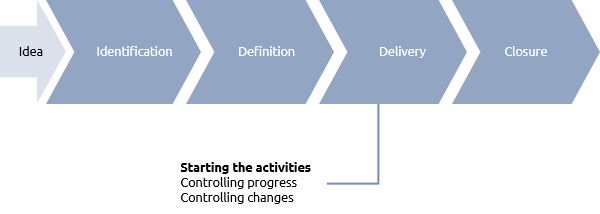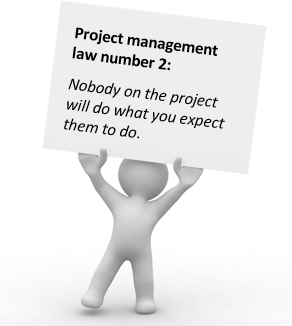
Where are we?
 We have finished the definition process, and are ready to start the project. We now need to get the activities started on time, by the people to whom the activities were assigned. It is best to remember project management law number 2 at this stage.
We have finished the definition process, and are ready to start the project. We now need to get the activities started on time, by the people to whom the activities were assigned. It is best to remember project management law number 2 at this stage.
Just as law number 1 sounded rather rude but was actually an excellent guide as to how to approach the definition phase, law number 2 guides us in the delivery phase.
Just because you have produced a schedule and sent a copy to all concerned does not guarantee that:
-
anyone will read the plan – remember they are busy people;
-
everyone will understand it – you may be using people who have little or no understanding of projects, schedules and so on;
-
the key players will identify and diarise their activities.
Don’t worry, your team members are not evil or lazy, but they are probably not full-time on your project either. They will almost certainly have a regular day job to carry out, and your project will be an extra ‘opportunity’ thrown on the top of what may be already a 110% working day.
Something will have to give, and as their day job is probably worth more to them in terms of performance appraisal points than your project, you cannot blame them for adjusting their priorities accordingly.
And those are the people who actually thought about it – many of your team members will not get that far!
So law number 2 is telling us not to assume that your team members will automatically follow the schedule. You cannot leave it to chance or their ‘professionalism’ or their loyalty to you. You must guide and manage the situation, and you can do it in such a supportive way that the team members will think you are positively looking after their interests.
In order for this part of the process to work you must have a detailed schedule, whether it is a simple activity list or a slightly more complex Gantt chart doesn’t matter. As long as your plan tells you when each activity is due to start, and who has been assigned to it, you can run a simple ‘work authorisation’ process. It may sound grand but it is quite simple to do. It may save your project from the team member who forgets to start a key activity on the correct day.
Work authorisation system
Imagine a timeline for your project, as shown below. Imagine that Day T is the day when you want a specific activity to be started by Jim.

You must not assume that Jim will start on time. Remember, the schedule may have been drawn up several weeks or months ago – he may just have forgotten all about your project in the daily bustle of his proper job. If you do leave it then you will not find out that there has been a problem until day T+3 or T+5 or whenever the activity is supposed to be finished – and it’s too late to do anything about it.
So you need to have three conversations with Jim, preferably face-to-face, but via the telephone if necessary. An email does NOT suffice in this process, as you need to detect feelings and concerns about the activity.
Phone call 1 happens on Day T-7 (i.e. 1 week before the activity is supposed to start). You say:
-
“Hi Jim – as you may remember in a week’s time you are going to start Activity T for me on my project; is there any more information or guidance you need from me?”
-
“Is there any help I can get you before the activity starts?”
-
“Since we last spoke has anything happened that may have affected your availability for this activity?”
Probably Jim had forgotten the activity, so you are gently reminding him about it. You sound very supportive, so he doesn’t feel that you are hounding him.
The most important part of the conversation is the last part about anything that may have affected his availability. This is your opportunity to find out if, say, his boss has completely changed Jim’s priorities such that there is no time left for your activity. If there is such a problem then the earlier you find out about it the better – you may be able to manage your way around the problem.
Phone call 2 happens on Day T-2, and it is an exact repeat of Phone Call 1. However, now that Jim has had your T-7 reminder, he may have started to think about the activity and you may get some useful answers to the first two questions. You can jump in with help, information or whatever Jim needs. Again, the third part is most important.
Phone call 3 happens on Day T+1. Actually some project managers do it on Day T, but I think we should give Jim some space to organise himself and stay off his back until we really have a problem.
In Phone call 3 you ask some simple, non-pushy questions:
-
“Jim, did you manage to make a start on activity T?”
-
“Is it turning out the way you thought?”
-
“Is there anything you need from me to help you with it?”
None of these questions is concerned with hard-nosed progress-checking. We cover that in the next chapter. All we are trying to do is make sure that activities actually start on their designated day, or that we pick up potential problems early enough that we can deal with them.
Summary
Don’t get caught out assuming that your dedicated professional team members will even read the schedule, let alone follow it in any detail. They are busy people, and they need to be reminded about your project. The system is simple, but very effective.
Checklist
Create a diary system for yourself, based upon your project schedule… | …and plan 3 conversations for every activity |
Make your conversations supportive and non-pushy… | …but the team members will be aware of the nature of the call |
Always try to verify the availability of team members. | This is one of the principal reasons why projects run behind schedule |
Thanks to Mike Watson of Obsideo for providing this book





